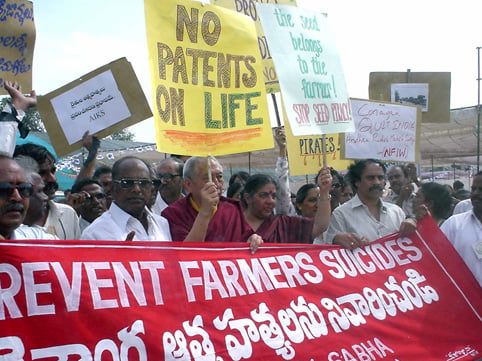
These are the names given to the genetically modified cotton seeds of Monsanto that now dominate more than 90% of India’s cotton crops. Until the spread of genetically modified hybrids, Indian farmers, relying on centuries of accumulated experience, had managed to develop varieties adapted to harsh local conditions; from plants adapted to saline soils to plants resistant to frost conditions.
All of this until 1993, when Monsanto introduced the first generation of genetically modified cotton plants to India. Initially, the company’s promises were tempting: “greater resistance to pests, greater production, greater income for farmers,” but the final result was and continues to be nightmarish. In the last two decades, more than 300,000 Indian farmers have been driven to suicide due to the destitution imposed on them by Monsanto with GMOs, drowned in enormous debts, with diminished yields, with degraded properties, tied hand and foot to the company’s plow.
Indeed, during the first few years production had increased, but the cost was enormous. The genetically modified seeds produced sterile plants that were unable to reproduce; for every new cultivation, farmers were obliged to purchase Monsanto’s seed. Moreover, the survival of genetically modified plants depended exclusively on the use of powerful pesticides, patented by Monsanto (the company is notorious not only for GMOs, but also for the “nuclear bomb” of pesticides, Roundup – as well as for Agent Orange from the Vietnam War). The company’s harsh chemicals eliminated not only the parasites, leaving the genetically modified plants unharmed, but also the native varieties, causing them to disappear. Each new cycle required increasingly intensive use of pesticides, which on one hand led to the degradation of arable land and on the other to the emergence of new super-resistant parasites.
When it became apparent that Monsanto’s monopolistic control was leading with mathematical precision to destruction, many farmers tried to create their own hybrids by crossing Monsanto’s GMOs with local, old varieties, in order to produce new, more resistant and fertile hybrids; but the company dragged them to court with charges of “genetic piracy” and “intellectual property theft.” In 2009, the company informed the Indian government that the super-parasites that had emerged due to its aggressive chemical campaign had now developed great resistance to pesticides, had spread to most cultivable areas, and therefore farmers should turn to the new generation of GMOs with two mutated genes instead of one.
Think of this scheme abstractly: a genetically modified organism is introduced, supposedly saving against parasitic organisms, it is imposed monopolistically, it is receptive only to specific strong drugs, the combination of GMO and drugs leads on one hand to the degradation of the biosphere and on the other to the emergence of stronger parasitic organisms, the answer is the introduction of even more modified organisms in combination with stronger drugs, and again the cycle from the beginning… and again… and again…
If this scheme was effectively applied with devastating results in the agricultural economy, consider the equivalent in the health economy. And if you can’t grasp it, it doesn’t matter, perhaps Bayer will take care of it, which recently acquired Monsanto…
